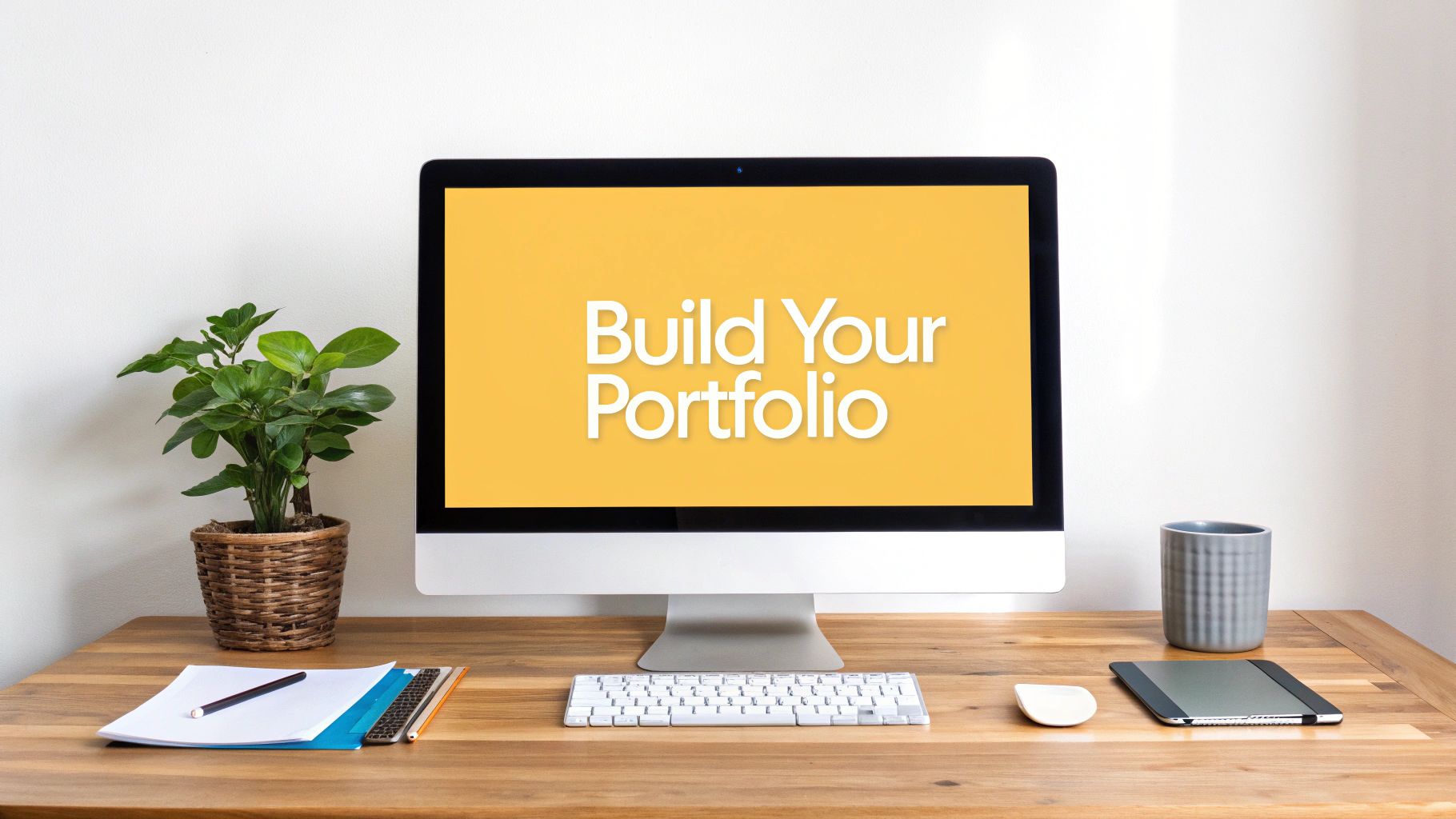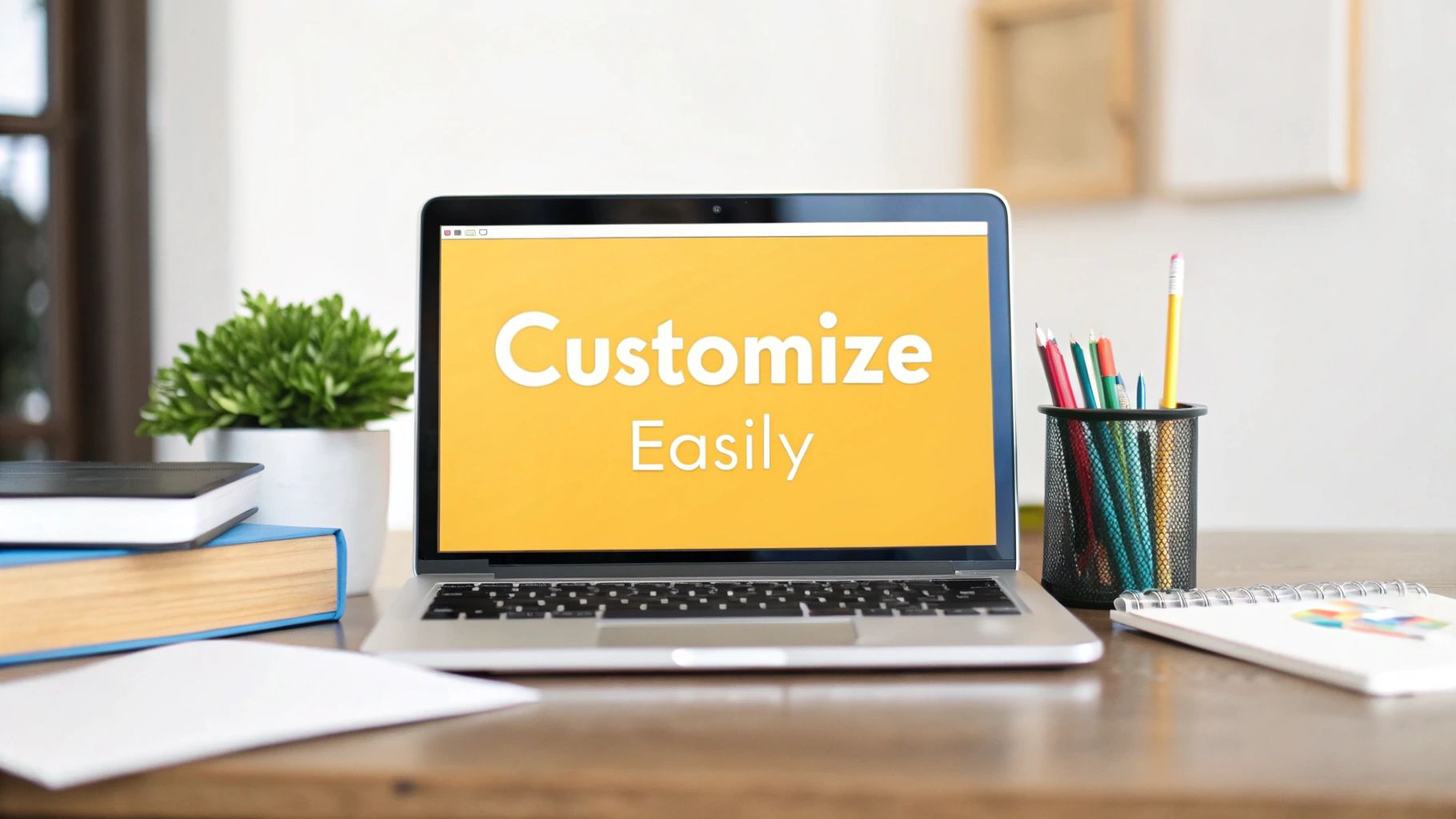Top 12 Best Portfolio Website Builders: The Ultimate Guide for Creatives

Understanding The Portfolio Website Builder Landscape
Creating an online portfolio has become essential for creative professionals. As simple web pages no longer suffice, portfolio website builders have emerged as powerful tools that let creatives build professional sites without coding expertise. From photographers and designers to architects and writers, these platforms enable anyone to showcase their work effectively online.
The rapid adoption of these tools shows no signs of slowing. Market projections indicate the website builder industry will grow at 6.9% annually through 2032, reaching over $14.4 billion globally. This suggests continued innovation from major platforms like Wix, Squarespace, and GoDaddy as they develop more capable portfolio building tools. Learn more about website builder market trends.

Key Features to Consider
While the best platform depends on your specific creative field, several essential features matter across all portfolio websites:
- Customization: Look for extensive template options, flexible design tools, and custom coding capabilities to create a unique portfolio that reflects your style
- Mobile Responsiveness: Your portfolio must look great on all devices as more people browse on phones and tablets
- SEO Tools: Built-in features that help optimize your content for search engines are crucial for attracting potential clients
- Integration Options: The ability to connect with social media, email marketing, and analytics tools helps expand your reach and measure success
Evaluating Platform Stability and Support
Beyond features, consider these factors for long-term success:
- Technical Reliability: Choose a platform with minimal downtime to ensure your portfolio stays accessible
- Active Community: Access to tutorials, resources, and peer support proves invaluable, especially when starting out
- Company Track Record: Select an established platform committed to ongoing improvements that will support your portfolio's growth
Taking time to evaluate these aspects helps you choose a platform aligned with your creative goals. The right choice creates a strong foundation for showcasing your work and connecting with ideal clients.
Leading Portfolio Website Builders: Features Comparison
When selecting a portfolio website builder, understanding what each platform offers is essential. Different creators have different needs - photographers need excellent image display capabilities, while developers may require custom code integration. Making the right choice means evaluating key aspects like customization options, mobile performance, and integration features that match your specific goals.
Customization and Mobile Responsiveness
A great portfolio needs flexibility in design. Beyond just picking an attractive template, look for platforms that give you detailed control over layouts, fonts, colors, and interactive elements. Mobile optimization is equally crucial - with most web traffic now coming from phones and tablets, your portfolio must look and function perfectly across all devices. This ensures visitors can properly view and interact with your work regardless of how they access it.
Integration Capabilities and SEO
Connecting your portfolio to other online tools helps expand your reach. The ability to integrate with social media, email marketing platforms, and analytics services lets you promote your work and track performance effectively. Good SEO capabilities are also vital for helping potential clients find you organically. Look for features that help optimize your content and metadata to improve search rankings and visibility in your field.
Platform Comparison Table
Here's how some major portfolio website builders stack up:
| Feature | Wix | Squarespace | GoDaddy |
|---|---|---|---|
| Customization | High | Medium | Medium |
| Mobile Responsiveness | Excellent | Excellent | Good |
| SEO Tools | Robust | Good | Basic |
| Integrations | Extensive | Moderate | Moderate |
| Pricing | Varies, free and paid plans available | Varies, paid plans available | Varies, free and paid plans available |
This comparison shows the relative strengths of each platform. It's worth noting that Wix currently dominates with a 45% market share among website builders, reflecting its widespread adoption for portfolio creation.
Choosing the Right Features
Focus on features that directly help you connect with clients and showcase your work effectively. While fancy additions might seem appealing, prioritize practical elements like contact forms, clear calls-to-action, and client testimonials. These core features will help turn portfolio visitors into actual clients, making your site an effective tool for growing your business.
Pricing and Value Proposition
When selecting a portfolio website builder, consider the complete picture beyond just the monthly fees. You need to evaluate the total investment against potential returns, understanding where to spend strategically to create an effective online portfolio.
Free vs. Premium: Finding the Right Balance
Most portfolio platforms offer free starter plans, which work well for students and early-career professionals. However, these plans typically come with trade-offs - you may have to use the platform's subdomain rather than your own domain name, face storage limits, or have fewer design options. This can make your portfolio appear less professional.
Premium plans open up key features that help you grow professionally. With a paid plan, you get your own domain name, better design tools, the ability to sell work directly, and marketing capabilities. For many creators, these upgrades pay off quickly through increased client inquiries and higher rates for projects.
Hidden Costs and Long-Term Expenses
Look beyond the basic subscription price to other potential costs. You may need to pay for domain registration, email tools, or premium design elements. Also consider the value of your time - a user-friendly platform might cost more monthly but save countless hours in management and updates. For instance, if you need coding skills for basic changes on a cheaper platform, the lower price may not be worth the extra time investment.
Plan for future growth when choosing a platform. As you add more work samples and get more visitors, you'll likely need additional storage and features. Picking a portfolio builder that makes upgrading simple helps avoid the hassle of moving your entire site later. The platform's financial health also matters - for example, Wix earned $1.56 billion in 2022, showing strong investment in product development. Learn more about website builder performance here.
Maximizing Your Return on Investment
Think of your portfolio as a business investment. Put money into features that directly help you land clients and projects, like professional templates, SEO capabilities, and clear contact options. Use analytics to track which elements perform best and adjust your approach based on real data.

By carefully evaluating costs versus benefits and choosing features that support your professional goals, you can select a portfolio platform that delivers real value and helps build lasting success.
AI-Powered Portfolio Creation
Creating a portfolio that stands out requires more than displaying your work - it needs thoughtful presentation and design. Artificial Intelligence (AI) tools are making this process easier and more effective by offering new capabilities within portfolio website builders.
Streamlining Workflow with AI
AI features can handle many time-consuming portfolio tasks automatically. Image organization becomes simpler with AI-powered tagging and categorization that efficiently manages large collections of work. The technology also optimizes images for different devices and screen sizes, ensuring your portfolio loads quickly and looks great everywhere. This automatic optimization gives you more time to focus on creating while maintaining a professional presentation.
Enhancing Design with AI
AI-powered design assistants work like having a virtual design consultant available 24/7. They can suggest complementary layouts, colors, and typography based on your existing content and style preferences. While these AI suggestions provide helpful starting points, they're meant to support rather than replace your creative decisions. The key is using AI recommendations as inspiration while maintaining your unique artistic vision.
Creating Engaging Portfolio Experiences
Modern AI features help make portfolios more interactive and personalized. AI-driven content recommendations analyze visitor behavior to showcase your most relevant work first, helping capture and keep attention. AI can also power helpful interactive elements like chatbots to answer common questions or personalized welcome messages that make your portfolio feel more welcoming and professional.
When choosing a platform, consider how AI capabilities fit your needs. For example, GoDaddy offers an AI website builder that helps create professional-looking portfolios quickly, even without design experience. Combined with marketing and e-commerce tools, this makes it a solid choice for creative professionals and small businesses. Learn more about top portfolio platforms in this comprehensive guide.
The Future of AI in Portfolio Building
While AI integration in portfolio builders is still developing, the technology continues to advance rapidly. We can expect even more capable AI features to emerge, giving creative professionals new ways to build compelling and effective online portfolios. The best portfolio platforms will be those that thoughtfully incorporate AI while keeping the focus on showcasing your unique work and vision.
SEO and Marketing Integration
Having a great portfolio website means nothing if potential clients can't discover it. That's why integrating Search Engine Optimization (SEO) and strategic marketing from day one is crucial for attracting clients through your online portfolio.
Optimizing Your Portfolio for Search Engines
Most quality portfolio platforms include SEO tools to boost your visibility in search results. You can use these to optimize your site's metadata - the page titles and descriptions that help search engines understand your content. A photographer, for example, would include terms like "portrait photography," "wedding photographer," or "commercial photography" to connect with clients searching those services. Beyond metadata, weave these relevant keywords naturally into your project descriptions and blog posts to further signal your expertise to search engines.
Leveraging Built-In Marketing Tools
The best portfolio builders provide essential marketing features to promote your work effectively. This typically includes social media integration, email list building tools, and analytics tracking. Adding links to your social profiles lets potential clients see more of your work across platforms. Setting up an email signup form helps you build an engaged audience for sharing updates about new projects. Regular analytics reviews reveal which content resonates most with visitors, helping you improve your portfolio over time.
Engaging Your Audience and Building a Community
Your portfolio should do more than showcase work - it should create meaningful connections. Keep your site fresh by adding new projects regularly to show active growth. Consider starting a blog to share your creative process and industry insights. Writing about trends or giving behind-the-scenes looks at projects helps establish your expertise and attracts clients who value your knowledge and approach.
Real-World Examples of Effective Portfolio Marketing
Many successful creatives use their portfolios as central marketing hubs that consistently attract clients through search and social channels. Take photographers who rank well for location-specific terms, helping local clients find them. Or designers who blog regularly about their field while highlighting client success stories, building authority that leads to new opportunities. Study these examples to develop strategies that work for your own portfolio and career goals. 
Making Your Final Decision
Picking the right portfolio website builder doesn't have to be complicated. With a clear understanding of what matters most for your work, you can make a confident choice that helps you succeed online. Let's break down the key factors to consider.
Defining Your Portfolio Needs
Start by making a list of your essential features. Each creative field has unique requirements - photographers need excellent image galleries, writers want strong blog tools, designers require detailed customization options, and developers often need code embedding capabilities. Think about what specific tools will help showcase your work effectively. For instance, if you're a photographer who frequently updates your portfolio from your phone, mobile-friendly image uploads should be high on your list.
Balancing Cost and Value
Consider how much you can invest in your portfolio site. While free plans offer a starting point, they typically include restrictions like limited storage or required platform branding. Paid plans provide important tools like custom domains, advanced design options, and marketing features that help attract clients. Take time to compare monthly costs against the features you need, and watch for extra expenses like domain registration fees or premium theme costs.
Evaluating User Experience and Support
Your comfort level with website building should guide your platform choice. If you're new to creating websites, platforms like Wix or Squarespace offer simple drag-and-drop tools. More experienced users might prefer Webflow for its custom coding capabilities. Good support resources are also crucial - look for platforms that provide helpful tutorials, active user communities, and responsive customer service teams.
Prioritizing SEO and Marketing
Think carefully about how you'll promote your work online. Strong SEO tools help potential clients find you through search engines. Check for features that let you edit metadata, customize URLs, and connect with Google Analytics. Built-in marketing tools like social media integration and email signup forms make it easier to grow your audience. Consider which promotional features will best help you reach your target clients.

By carefully considering these key factors, you can select a portfolio platform that effectively showcases your work and helps you connect with clients. Ready to create your online presence? Start building your personalized link-in-bio page with Linkero today!